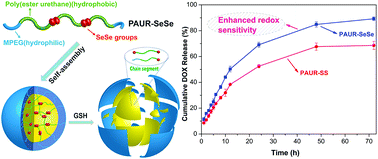Enhanced bioreduction-responsive biodegradable diselenide-containing poly(ester urethane) nanocarriers†
Abstract
Stimuli-responsive nanocarriers have been limited for bench-to-bedside translation mainly because the stimuli sensitivity and responsive rate are not high enough to ensure sufficient drug concentration at the target sites for superior therapeutic benefits. Herein, we reported an enhanced bioreduction-responsive and biodegradable nanocarrier based on the amphiphilic poly(ester urethane) copolymers (PAUR-SeSe) bearing multiple diselenide groups on the backbone. The copolymer could spontaneously self-assemble into stable micelles in aqueous medium with an average diameter of 68 nm, which could be rapidly disassembled in a reductive environment as a result of the reduction-triggered cleavage of diselenide groups. Furthermore, the PAUR-SeSe micelles showed an enhanced drug release profile and cellular uptake compared with the disulfide-containing analogue (PAUR-SS). CCK8 assays revealed that the antitumor activity of DOX-loaded PAUR-SeSe micelles was much higher than that of DOX-loaded PAUR-SS micelles. Besides, the blank micelles and degradation products were nontoxic up to a tested concentration of 50 μg mL−1. Therefore, the enhanced therapeutic efficacy and good biocompatibility demonstrated that this drug nanocarrier had great potential for smart antitumor drug delivery applications.



 Please wait while we load your content...
Please wait while we load your content...